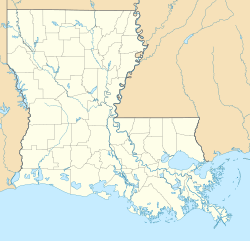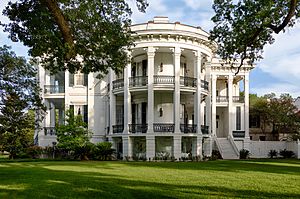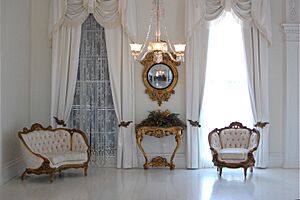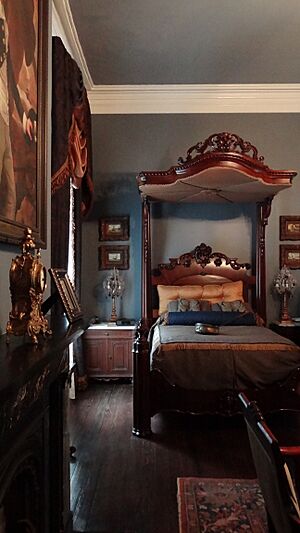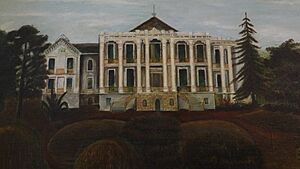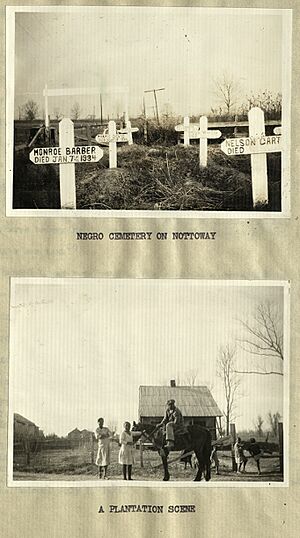Nottoway Plantation facts for kids
Quick facts for kids |
|
|
Nottoway Plantation House
|
|
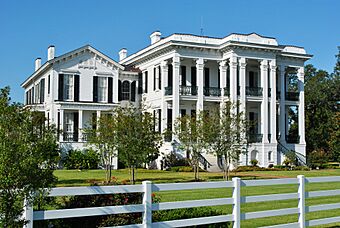
Plantation big house, Nottoway (2011)
|
|
| Location | 31025 LA 1 |
|---|---|
| Nearest city | White Castle, Louisiana |
| Area | 15 acres (6.1 ha) |
| Built | 1859 |
| Architect | Henry Howard |
| Architectural style | Greek Revival, Italianate |
| Demolished | May 15, 2025 |
| NRHP reference No. | 80001733 |
| Added to NRHP | June 6, 1980 |
Nottoway Plantation, also known as Nottoway Resort, was a huge historic house in White Castle, Louisiana. It was built in 1859 for a man named John Hampden Randolph. The house was designed in the Greek Revival and Italianate styles.
With over 53,000 square feet (4,900 m2) of space, Nottoway was once the largest surviving plantation house from before the American Civil War in the Southern United States. Sadly, a fire destroyed the main house on May 15, 2025. However, some other historic buildings on the property are still standing.
Contents
The Grand House and Its Surroundings
Building Design
John Randolph hired a famous architect, Henry Howard, from New Orleans to design his dream home. Randolph wanted the house to be very grand, no matter the cost.
The three-story house was made of wood, with a brick base that looked like stone. It faced east, towards the Mississippi River. The front of the house had a unique design, with a bedroom section on one side and a large curved area with balconies on the other.
The main part of the house was tall and narrow, with a central entrance. The main living areas on the second and third floors were each about 15.5 feet (4.7 m) high. The balconies had beautiful iron railings made in New Orleans.
Two curved granite staircases led up to the second floor. These steps were built with separate sides for ladies and gentlemen. This was because it was considered impolite for men to see women's ankles under their long skirts!
The house had 22 tall, square columns that made it look even taller. Above these columns, there were decorative carvings. At the back of the house, there was a two-story wing called a garçonnière. This is where the Randolph sons lived.
Nottoway was finished in 1859. It cost about $80,000, which would be a huge amount of money today. Randolph actually destroyed the architect's plans after the house was built. He didn't want anyone else to build a house exactly like his!
Inside Nottoway
Nottoway had a lot of space inside, spread over three floors. It had 64 rooms, 165 doors, and 200 windows. Many of the windows were so large they could also be used as doors.
The house had some very modern features for the 1800s. It had a bathroom on each floor with flushing toilets. It also had hot and cold running water and gas lighting. A special bell system allowed servants to be called from anywhere in the house.
The most important rooms were on the second floor. The entrance hall was 12 feet (3.7 m) wide and 40 feet (12 m) long. Beautiful Baccarat crystal chandeliers hung from the 15.5 feet (4.7 m) high ceilings. The doors were 11 feet (3.4 m) tall and had fancy German porcelain doorknobs.
One of the most special rooms was the White Ballroom. John Randolph loved this room the most. He had it painted completely white, even the floor! This was to highlight the beauty of his seven daughters. Six of them were married in this very room. The ballroom had two fireplaces with white marble decorations. There was also a mirror placed so ladies could check if their ankles or large hoop skirts were showing.
Next to the entrance hall were a study for gentlemen and the formal dining room. These rooms had black marble fireplaces. The dining room's decorations featured pink camellias, which were Emily Randolph's favorite flowers. This was the only room with colored decorations.
A grand staircase made of Honduran mahogany led to the third floor. This floor had a family parlor and many bedrooms. One bedroom had one of the original bathrooms. There was also a small room used as a nursery for Julia Marceline, the only Randolph child born at Nottoway. During the Civil War, Emily Randolph hid valuable jewelry inside a bedpost.
The first floor, which was like a basement, was later turned into a restaurant and a small museum. Originally, this area held the laundry, a dairy, a wine cellar, and even a 10-pin bowling alley for the children!
The Gardens and Grounds
The original gardens at Nottoway were designed by John Nelson. They included many fruit and citrus trees, magnolia trees, rose bushes, and strawberry plants. There were also flower and vegetable gardens.
However, over time, the Mississippi River eroded some of the land. The original gardens no longer exist. Today, the house is very close to the river levee. The grounds now have a small formal hedge garden and a fountain courtyard.
Around the house, there are modern buildings used for offices and events. In 2008, new buildings were added, including a carriage house and a ballroom. Nine small cottages were also built, designed like the original homes for the enslaved workers. To the north of the house, there are reconstructed stables, now used as a ballroom. The Randolph family cemetery is also located there. The family's remains were moved there in 2003.
Nottoway's Story
The 1800s
John Hampden Randolph was born in Virginia in 1813. His family was well-known. He moved to Mississippi with his family when he was young.
John married Emily Jane Liddell in 1837, and they had eleven children. John first grew cotton on his plantation. But he thought growing sugar cane would make more money. So, in 1842, he moved his family to southern Louisiana. He bought a 1,650 acres (6.7 km2) cotton plantation and named it Forest Home.
He changed his plantation to grow sugar cane and built the first steam-powered sugar mill in the area. This helped him earn three times more money than he did with cotton. Within ten years, he owned over 7,116 acres (28.80 km2) of land. He also forced 176 people to work for him as slaves. This made him one of the biggest slave owners in the Southern United States.
In 1855, Randolph bought more land to build a grander home. He named it "Nottoway" after the county in Virginia where he was born.
Randolph made his enslaved workers build his new house. He also designed the nearby Belle Grove Plantation. Randolph and the owner of Belle Grove, John Andrews, were known to have a friendly competition, even with their homes.
To build Nottoway, cypress logs were soaked in water for six years, then cut and dried. This "virgin cypress" wood was very strong and resisted termites. Enslaved African Americans made the bricks by hand. Many skilled workers, like carpenters and brick masons, also helped build the house. Nottoway was finished in 1859. Other buildings were also built, including homes for enslaved workers, a school, a greenhouse, and a stable.
Soon after the house was finished, the American Civil War began. Randolph supported the Confederacy with money. He sent his three sons to fight, and his oldest son, Algernon Sidney Randolph, died in the war.
As the war got closer to Nottoway, Randolph took 200 enslaved people to Texas to grow cotton there. His wife, Emily, stayed at Nottoway with their younger children. She hoped her presence would protect the house. Both U.S. Army and Confederate soldiers occupied the plantation. The grounds were damaged, and animals were taken, but Nottoway survived. Only one small cannonball hit a column, and it didn't fall out until 1971!
Even after the Thirteenth Amendment ended slavery, 53 people who had been enslaved by John Randolph continued to work for him as low-paid laborers. When he returned from the war, most of them came back with him because they had few other choices.
The sugar business was not as good after the war. By 1875, Nottoway was much smaller. John Randolph died at Nottoway in 1883. He left the plantation to his wife, Emily.
Emily Randolph sold the plantation in 1889 for $50,000. She shared the money equally among her nine surviving children and herself. She passed away in Baton Rouge in 1904.
The 1900s
New owners took over Nottoway. The Landry and Dugas families owned it until 1909. Then, a sugar planter named Alfonse Hanlon bought it. But he lost Nottoway in 1913 because his crops failed, and he had money problems.
Dr. Whyte G. Owen bought the plantation for $10,000. He tried to run it as a sugar plantation but wasn't successful. He sold off much of the land, keeping only the house and the surrounding property. After he died in 1949, his son Stanford inherited Nottoway. Stanford and his wife Odessa lived there until he died in 1974.
Odessa Owen lived alone in the huge house after that. She tried to keep it up, but it was difficult with limited money. Knowing she couldn't care for it properly, she sold Nottoway to Arlin K. Dease in 1980. Dease had restored other old mansions. Odessa was allowed to live in the house until she passed away in 2003.
Arlin Dease worked hard to restore Nottoway. He had a team of 40 to 60 men working long hours. He opened the house to the public just three months after buying it. In 1985, Dease sold Nottoway to Paul Ramsay, a billionaire from Australia, and Robert E. Galloway. They saw Nottoway as a place that could offer more than just history. They wanted to expand it into a resort. Ramsay spent over $15 million on the property over two decades, adding more places to stay and things to do.
The 2000s
Paul Ramsay passed away in 2014. During his time, Nottoway became a popular resort. The house was added to the National Register of Historic Places in 1980. It was a very popular place for tourists in southern Louisiana. The current owner of the home is Dan Dyess.
On May 15, 2025, a fire started in the southern part of the plantation home. It caused a lot of damage to the main house. Some buildings were saved, like the garçonnière, the Overseer's Cottage, other small cottages, the Randolph Ballroom, and the Randolph family cemetery.
The fire was first contained to one wing, but embers later reignited. The fire spread and destroyed the main house. Now, only the concrete foundations of the ground floor and parts of the southeast side of the mansion remain. The owners had initially said they planned to rebuild and restore the historic mansion.
See also
 In Spanish: Nottoway Plantation para niños
In Spanish: Nottoway Plantation para niños
- National Register of Historic Places listings in Iberville Parish, Louisiana
- List of plantations in Louisiana


